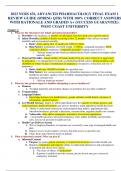Exam (elaborations)
2023 NURS 676, ADVANCED PHARMACOLOGY FINAL EXAM 1 REVIEW GUIDE (SPRING QTR) WITH 100% CORRECT ANSWERS WITH RATIONALE AND GRADED A+ (SUCCESS GUARANTEE): WEST COAST UNIVERSITY
- Course
- Institution
2023 NURS 676, ADVANCED PHARMACOLOGY FINAL EXAM 1 REVIEW GUIDE (SPRING QTR) WITH 100% CORRECT ANSWERS WITH RATIONALE AND GRADED A+ (SUCCESS GUARANTEE): WEST COAST UNIVERSITY Chapter 1: 1. What are the risk factors for infant and maternal mortality? a. Mortality is the incidence or number of ind...
[Show more]



